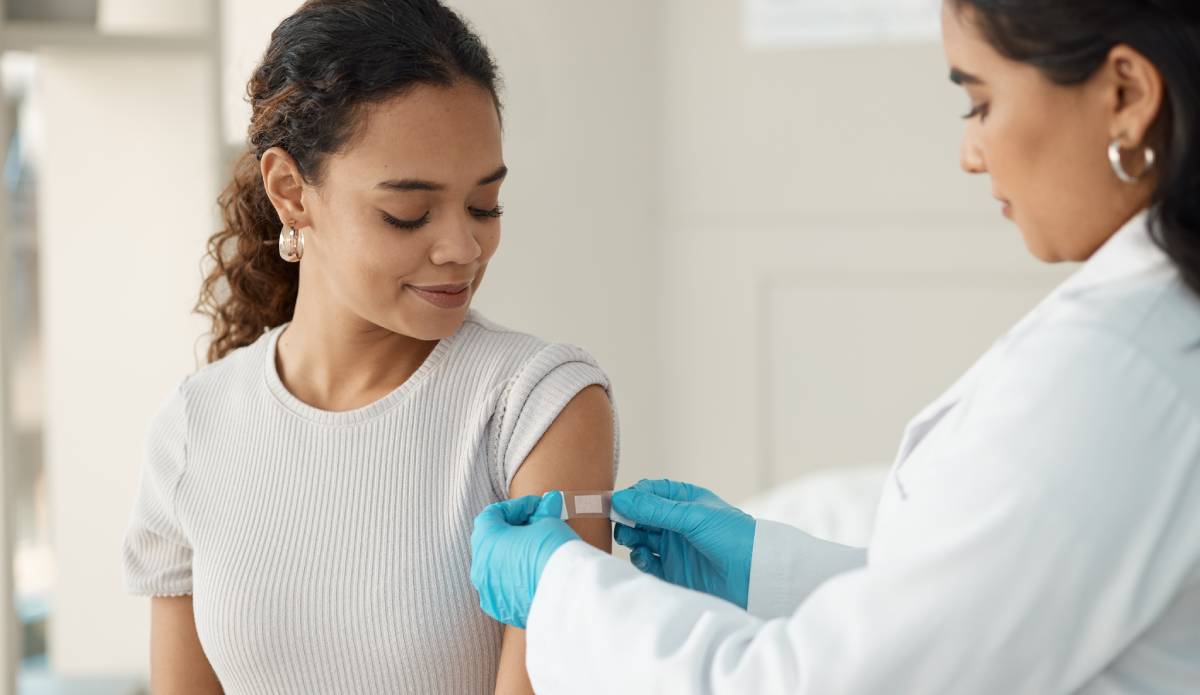As the weather becomes cooler in the fall, infectious respiratory diseases begin circulating at higher levels. Typically, the common cold and influenza are major drivers of fall and winter illnesses. During the winter months of 2022, hospitals were swamped by a surge of respiratory illnesses that killed more than 100,000 people in the United States over the course of four months (5). In this so-called “tripledemic,” over a million people were hospitalized from influenza, respiratory syncytial virus (RSV), and COVID-19 (1). This fall is the first virus season when vaccines are available for the three infectious diseases most responsible for severe illness and hospitalization at the moment, including RSV (1). Vaccinating our communities remains the most effective way to protect vulnerable populations against severe illness, hospitalization, and death during the virus season.
The FDA approved an updated vaccine for COVID-19 this year on September 11, and the CDC recommended the same vaccine the following day (2). The new monovalent vaccine targets the XBB.1.5 variant, the dominant COVID-19 variant over the past few months (2). As expected, the XBB.1.5 variant has waned in the time that it took to develop the new vaccine (4). Now, there are a number of COVID-19 variants in circulation that are closely related to the XBB.1.5 vaccine, so experts expect that the new vaccine will offer adequate protection against these variants (4). Anyone age five years or older who has not received a COVID-19 vaccine in the past two months is eligible to receive the new vaccine (3). Children between the ages of 6 months and four years of age can also receive the new vaccine, either as their yearly COVID-19 vaccine or as the primary series of vaccines (3).
At the start of the pandemic, the number of cases of influenza and RSV decreased dramatically in response to masking regulations and social distancing (5). With the relaxation of public health measures over the last couple of years, RSV and flu cases have now surpassed pre-pandemic levels (5). Furthermore, the circulation patterns of these viruses have shifted; for example, the flu peaked in December last season instead of February (3). Considering these new post-pandemic patterns, experts recommend getting the influenza vaccine by the end of October to prepare for the upcoming surge. Even though COVID-19 continues to lose priority in public health efforts and societal sentiment, staying up to date on vaccines for these diseases is essential this fall.
RSV, or respiratory syncytial virus, is a lesser-known respiratory virus that poses a significant risk for young children, older people, and immunocompromised individuals (3). Last year, RSV peaked earlier than before the pandemic and remained in circulation for longer. However, this year, cases have already been on the rise in the Southeast, suggesting that the virus may have resumed its pre-pandemic schedule (3). For the first time this year, RSV vaccines are available for older adults (1). Pfizer’s and GSK’s RSV vaccines have been approved for use in older adults who may be at risk of severe respiratory illness (4). The FDA has also approved the Pfizer vaccine to be administered to pregnant parents toward the end of their pregnancy in order to pass on protection to newborn infants (4). Children who did not receive protection against RSV from their parents can also be treated with an approved monoclonal antibody therapy that prevents respiratory illness in infants for up to six months (3). Because the RSV vaccines are so new, information on their safety is still limited (3). As a result, the RSV vaccines are only approved for high-risk older patients as of now (3).
Health experts have cautioned people to stay alert to rises in infections this fall. Fortunately, more tools are available to limit the impact of these viruses. Receiving vaccines this fall against common infectious diseases will help reduce mortality and morbidity due to the flu, RSV, and COVID-19.
References
1) “CDC Recommends Updated COVID-19 Vaccine for Fall/Winter Virus Season.” Center for Disease Control and Prevention, Sept 12 2023, https://www.cdc.gov/media/releases/2023/p0912-COVID-19-Vaccine.html
2) Cohen, Sandy. “What you need to know about new vaccines for flu, COVID and RSV.” UCLA Health, Sept 12 2023, https://www.uclahealth.org/news/what-you-need-know-about-new-vaccines-flu-covid-and-rsv
3) Mandavilli, Apoorva. “Three Shots for Fall: What You Need to Know.” The New York Times, Sept 14 2023, https://www.nytimes.com/article/flu-covid-rsv-vaccines.html
4) Neergaard, Lauran. “Updated COVID shots are coming. They’re part of a trio of vaccines to block fall viruses.” The Associated Press, Sept 9 2023, https://apnews.com/article/covid-flu-rsv-vaccines-tripledemic-2a55728638c1c0879ce58deeeb0196bf
5) Rivkees, Scott A. “How to Avoid the Tripledemic of Respiratory Diseases This Winter.” TIME, Sept 16 2023, https://time.com/6314785/how-to-avoid-the-tripledemic-of-respiratory-diseases/
